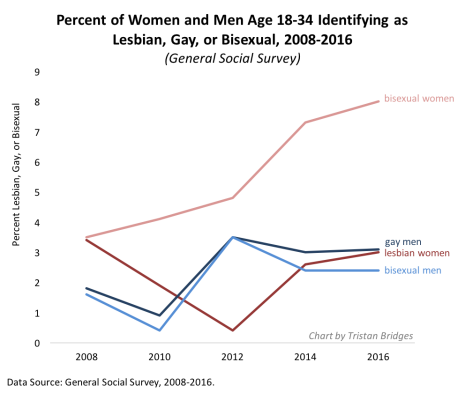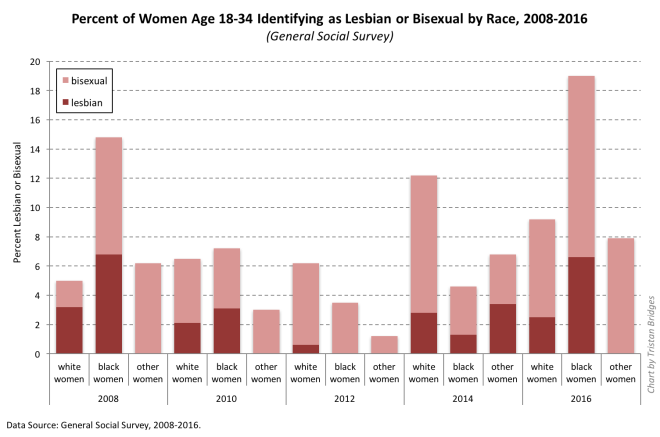Originally posted at Inequality by (Interior) Design.
I’ve been following a couple different data sets that track the size of the LGB(T) population in the United States for a few years. There’s a good amount of evidence that all points in the same direction: those identifying as lesbian, gay, bisexual, and possibly transgender too are all on the rise. Just how large of an increase is subject to a bit of disagreement, but the larger trend is undeniable. Much of the reporting on this shift treats this as a fact that equally blankets the entirety of the U.S. population (or only deals superficially with the really interesting demographic questions concerning the specific groups within the population that account for this change).
In a previous post, I separated the L’s, G’s and B’s because I suspected that more of this shift was accounted for by bisexuals than is often discussed in any critical way (*the GSS does not presently have a question that allows us to separate anyone identifying as transgender or outside the gender binary). Between 2008 and 2016, the proportion of the population identifying as lesbian or gay went from 1.6% to 2.4%. During the same period, those identifying as bisexual jumped from 1.1% to 3.3%. It’s a big shift and it’s even bigger when you look at how pronounced it is among the groups who primarily account for this change: women, people of color, and young people.
The thing about sexual identities though, is that they’re just like other kinds of meaningful identities in that they intersect with other identities in ways that produce different sorts of meanings depending upon what kinds of configurations of identities they happen to be combined with (like age, race, and gender). For instance, as a sexual identity, bisexual is more common than both lesbian and gay combined. But, bisexuality is gendered. Among women, “bisexual” is a more common sexual identity than is “lesbian”; but among men, “gay” is a more common sexual identity than “bisexual”–though this has shifted a bit over the 8 years GSS has been asking questions about sexual orientation. And so too is bisexuality a racialized identity in that the above gendered trend is more true of white and black men than men of other races.
Consider this: between 2008 and 2016, among young people (18-34 years old), those identifying as lesbian or gay went from 2.7% to 3.0%, while those identifying as “bisexual” increased twofold, from 2.6% to 5.3%. But, look at how this more general change among young people looks when we break it down by gender.

Looked at this way, bisexuality as a sexual identity has more than doubled in recent years. Among 18-34 year old women in 2016, the GSS found 8% identifying as bisexual. You have to be careful with GSS data once you start parsing the data too much as the sample sizes decrease substantially once we start breaking things down by more than gender and age. But, just for fun, I wanted to look into how this trend looked when we examined it among different racial groups (GSS only has codes for white, black, and other).
Here, you can see a couple things. But one of the big stories I see is that “bisexual” identity appears to be particularly absent among Black men in the U.S. And, among young men identifying as a race other than Black or white, bisexuality is a much more common identity than is gay. It’s also true that the proportions of gay and bisexual men in each group appear to jump around year to year. The general trend follows the larger pattern – toward more sexual minority identities. But, it’s less straightforward than that when we actually look at the shift among a few specific racial groups within one gender. Now, look at this trend among women.

Here, we clearly see the larger trend that “bisexual” appears to be a more common sexual identity than “lesbian.” But, look at Black women in 2016. In 2016, just shy of one in five Black women between the ages of 18 and 34 identified as lesbian or bisexual (19%) in the GSS sample! And about two thirds of those women are identifying as bisexual (12.4%) rather than as lesbian (6.6%). Similarly, and mirroring the larger trend that “bisexual” is more common among women while “gay” is more popular among men, “lesbian” is a noticeably absent identity among women identifying as a race other than Black or white just as “gay” is less present among men identifying as a race other than Black or white.
Below is all that information in a single chart. I felt it was a little less intuitive to read in this form. But this is the combined information from the two graphs preceding this if it’s helpful to see it in one chart.

What these shifts mean is a larger question. But it’s one that will require an intersectional lens to interpret. And this matters because bisexuality is a less-discussed sexual identification–so much so that “bi erasure” is used to address the problem of challenging the legitimacy or even existence of this sexual identity. As a sexual identification in the U.S., however, “bisexual” is actually more common than “gay” and “lesbian” identifications combined.
And yet, whether bisexual identifying people will or do see themselves as part of a distinct sexual minority is more of an open question. All of this makes me feel that we need to consider more carefully whether grouping bisexuals with lesbian women and gay men when reporting shifts in the LGB population. Whatever is done, we should care about bisexuality (particularly among women), because this is a sexual identification that is becoming much more common than is sometimes recognized.
Tristan Bridges, PhD is a professor at the University of California, Santa Barbara. He is the co-editor of Exploring Masculinities: Identity, Inequality, Inequality, and Change with C.J. Pascoe and studies gender and sexual identity and inequality. You can follow him on Twitter here. Tristan also blogs regularly at Inequality by (Interior) Design.
Comments 1
bolshevegan — June 14, 2017
What happened to lesbians in 2012??